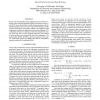Free Online Productivity Tools
i2Speak
i2Symbol
i2OCR
iTex2Img
iWeb2Print
iWeb2Shot
i2Type
iPdf2Split
iPdf2Merge
i2Bopomofo
i2Arabic
i2Style
i2Image
i2PDF
iLatex2Rtf
Sci2ools
ICMCS
2006
IEEE
2006
IEEE
Human Vision System Aware Exhaustive Block-Matching Algorithm
In this work, homomorphic image modeling is used to make the exhaustive block-matching algorithm (EBMA) more human vision system (HVS) aware, thus yielding visually pleasing sequences. Homomorphic signal processing is used to separate the luminous and the structural components of each frame; EBMA is then applied to both components to capture the luminous and the structural changes. The combination of these two techniques is utilized to simulate the structure preserving nature of HVS. Temporal irrelevancies are reduced by removing the excess motion fields from both components. The homomorphic EBMA (H-EBMA) processed sequences have superior visual quality despite mean PSNR values that are comparable to sequences produced by traditional EBMA.
| Added | 11 Jun 2010 |
| Updated | 11 Jun 2010 |
| Type | Conference |
| Year | 2006 |
| Where | ICMCS |
| Authors | David Lin, Paul Chau |
Comments (0)

